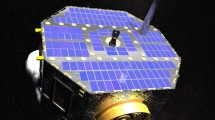Abstract
Thanks to remarkable new tools, such as the Goddard High Resolution Spectrograph (GHRS) on board the HST and the EUVE spectrometer on the interstellar side, and Ulysses particle detectors on the heliospheric side, it is possible now to begin to compare abundances and physical properties of the interstellar matter outside the heliosphere (from absorption features in the stellar spectra), and inside the heliosphere (from “in situ” or remote detection of the interstellar neutrals or their derivatives, the pick-up ions or the Anomalous Cosmic Rays detected by the two Voyager spacecraft).
Ground-based and UV spectra of nearby stars show that the Sun is located between two volumes of gas of different heliocentric velocities V and temperatures T (see also Linsky et al, this issue). One of these clouds has the same velocity (V= 25.6 km s−1 from λ= 255∘ and β=8∘) and temperature (6700 K) as the heliospheric helium of interstellar origin probed by Ulysses, and is certainly surrounding our star (and then the Local Interstellar Cloud or LIC). This Identification allows comparisons between interstellar constituents on both sides of the heliospheric interface.
Ly-alpha background data (absorption cell and recent HST-GHRS spectra) suggest that the heliospheric neutral H velocity is smaller by 5–6 km s−1 than the local cloud velocity, and therefore that H is decelerated at its entrance into the heliosphere, in agreement with interaction models between the heliosphere and the ISM which include the coupling with the plasma. This is in favor of a non negligible electron density (at least 0.05 cm3). There are other indications of a rather large ionization of the ambient ISM, such as the ionization equilibrium of interstellar magnesium and of sodium. However the resulting range for the plasma density is still broad.
The heliospheric neutral hydrogen number density (0.08–0.16 cm−3) is now less precisely determined than the helium density (0.013–0.017 cm−3, see Gloeckler, Witte et al, Mobius, this issue). The comparison between the neutral hydrogen to neutral helium ratios in the ISM (recent EUVE findings) and in the heliosphere, suggests that 15 to 70% of H does not enter the heliosphere. The comparison between the interstellar oxygen relative abundance (with respect to H and He) in the ISM and the heliospheric abundance deduced from pick-up ions is also in favor of some filtration, and thus of a non-negligible ionization.
For a significant ISM plasma density, one expects a “Hydrogen wall” to be present as an “intermediate” state of the interstellar H around the interface between “inside” and “outside”. Since 1993, the two UVS instruments on board Voyager 1 and 2 indeed reveal clearly the existence of an additional Ly-alpha emission, probably due to a combination of light from the compressed H wall, and from a galactic source. On the other hand, the decelerated and heated neutral hydrogen of this “H wall” has recently been detected in absorption in the spectra of nearby stars (see Linsky, this issue).
Similar content being viewed by others
References
Adams T.F., Frisch P.C. 1977, ApJ, 212, 3000
Baranov V.B, Malama Y. 1993, JGR, 98, 15157
Bertin P., Lallement R., Ferlet R., Vidal-Madjar A., Bertaux J.L., 1993, J. Geophys. Res., 98, A9, 15193
Cheng K.P., Bruhweiler F.C, 1990, ApJ 364, 673
Clarke J.T., Bowyer S., Fahr H., Lay G. 1984, Astronomy and Astrophysics, 139, 389
Clarke J.T., Lallement R., Bertaux J.L., Quemerais E. 1995, ApJ, 448, 893
Cox D.P., Reynolds R.J., 1987, ARA&A 25, 303
Cummings A. C., Stone E.C., 1990, 21 st Int. Cosmic Ray Conference 6, 202
Dupuis J., Vennes S., Bowyer S., ApJ, 455, 574
Fahr, H.J., 1991, A&A 241, 251
Fahr, H.J., Osterbart, O. and Rucinski, D. 1995, A&A, 294, N2, 584
Ferlet R., Lallement R., Vidal-Madjar A., 1986, Astronomy and Astrophysics, 163, 204
Frisch P.C., 1994, Science, 265, 1443
Frisch P.C., 1995, Space Science Reviews, 72, 499
Geiss & al, 1994, Astron. Astrophys., 282, 924
Gloeckler & al, 1993, Science, 261, 70
Gloeckler G, 1996, this issue
Jelinsky, P., Vallerga, J. and Edelstein, J., 1994, ApJ, 442, 653
Lallement R., Ferlet R., Vidal-Madjar A., Gry C., 1990, in “Physics of the Outer Heliosphere”, (Varsaw, Sept 89), Grzedzielski and Page, Edts, Pergamon.
Lallement R., Bertin P., 1992, Astronomy and Astrophysics, 266, 479
Lallement R., Bertaux J.L., Clarke J.T., 1993, Science, 260, 1095
Lallement R. Ferlet R., Lagrange A.M., Lemoine M., Vidal-Madjar A., 1995, Astronomy and Astrophysics, 304 (2), 461
Lallement R., Bertin P., Ferlet R., Vidal-Madjar A., Bertaux J.L., 1994, A&A, 286, 898
Lallement R., Clarke J.T., Malama Y., Quemerais E., Baranov V.B., Bertaux J.L., Fahr H.J., Paresce F., in “Science with the Space Telescope”, in press.
Lallement R. Ferlet R., 1996, Astronomy and Astrophysics, in press
Linsky J.L., Brown A., Gayley K. et al 1993, ApJ, 402, 694
Linsky J.L., et al 1995, ApJ, 451, 335
Linsky J.L., Wood B.E., 1996, ApJ, vol 462
Mayor M., Queloz D., 1995, Nature, Vol 378, 355
Mobius E., 1996, this issue
Phillips J.L., Bame S.J., Feldman W.C.,&al, 1995, Geophys. Res. Let. 22, 23, 3301
Quémerais E., Bertaux J.L., Sandel B.R., Lallement R., 1994, 290, 941
Quémerais E., Sandel B.R., Lallement R., Bertaux J.L., 1995, A&A, 299, 249
Quémerais E., Malama Y., Sandel B.R., Lallement R., Bertaux J.L., Baranov V.B., 1996, A&A, 308, 279
Rucinski D., and Bzowski M., 1995, Space Sci. Rev., 72, 467
Rucinski D., 1996 (private communication)
Summanen T., Lallement R., Quemerais E., 1996, JGR, in press
VaUerga, J. and Welsh, B., 1995, ApJ, 444, 202
Witte M. et al, 1993, Adv. Space Res., 6, (13), 121
Witte M. Banaskiewicz M., Rosenbauer H., 1996, this issue
Author information
Authors and Affiliations
Rights and permissions
About this article
Cite this article
Lallement, R. Relations between ISM inside and outside the heliosphere. Space Sci Rev 78, 361–374 (1996). https://doi.org/10.1007/BF00170822
Issue Date:
DOI: https://doi.org/10.1007/BF00170822




